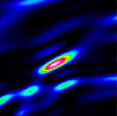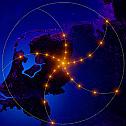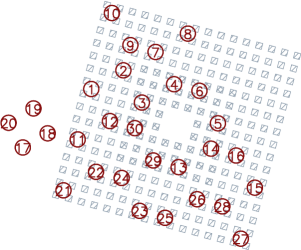The Science of LOPES
- Introduction: Cosmic bullets
 Cosmic rays are particles, such as protons, photons or atom nuclei, hitting the earth with energies over 1015eV, much more than can be produced by man-made particle accelerators. Their origins are still unclear. Especially the nature of ultra-high energy cosmic rays around 1020eV is a great mystery because of a lack of astrophysical accelerators within the GZK horizon. The measurement of high energy cosmic rays has therefore become a major target of large astroparticle experiments measuring cosmic ray air showers with Particle detectors.
Cosmic rays are particles, such as protons, photons or atom nuclei, hitting the earth with energies over 1015eV, much more than can be produced by man-made particle accelerators. Their origins are still unclear. Especially the nature of ultra-high energy cosmic rays around 1020eV is a great mystery because of a lack of astrophysical accelerators within the GZK horizon. The measurement of high energy cosmic rays has therefore become a major target of large astroparticle experiments measuring cosmic ray air showers with Particle detectors.
Air showers from particles above 1015eV, however, are known to also produce detectable radio flashes that could be used for diagnostic purposes. The emission can be explained with coherent synchrotron emission from electron-positron pairs in the shower. A new generation of software telescopes makes it now possible to study this radio emission in greater detail. The upcoming Low-Frequency Array LOFAR, operating at 10–200 MHz, initially designed for radio astronomical applications, will be a uniquely suited instrument to study cosmic rays and perhaps even neutrinos.
 Since LOFAR is a fully digital telescope, powerful interference mitigation techniques can be used. Due to its scaled nature, it will be sensitive for cosmic rays over a large energy range from 1016eV to approximately 1020eV. An extension to even 1022eV with nuMoon is even imaginable. However, in order to turn LOFAR into a successful astroparticle experiment, we need to understand and calibrate the radio emission better. We therefore built LOPES, a small LOFAR prototype station, to be operated in conjunction with existing particle detector arrays. LOPES will clarify the nature and properties of the radio emission from air showers and allow us to develop the necessary software needed to use LOFAR as a giant cosmic ray detector. The technique could also be of potential use for other cosmic ray experiments such as KASCADE, Pierre Auger, and for the Square Kilometer Array.
Since LOFAR is a fully digital telescope, powerful interference mitigation techniques can be used. Due to its scaled nature, it will be sensitive for cosmic rays over a large energy range from 1016eV to approximately 1020eV. An extension to even 1022eV with nuMoon is even imaginable. However, in order to turn LOFAR into a successful astroparticle experiment, we need to understand and calibrate the radio emission better. We therefore built LOPES, a small LOFAR prototype station, to be operated in conjunction with existing particle detector arrays. LOPES will clarify the nature and properties of the radio emission from air showers and allow us to develop the necessary software needed to use LOFAR as a giant cosmic ray detector. The technique could also be of potential use for other cosmic ray experiments such as KASCADE, Pierre Auger, and for the Square Kilometer Array.
The test array was first set up at the MPIfR in Bonn to check the hardware and develop the software. Later, it was installed at the KASCADE experiment in Karlsruhe. This is a running and well calibrated air shower experiment, which provides LOPES with a suitable trigger and reconstructed shower parameters. These parameters act as a starting point for LOPES and are used to calibrate its results.
